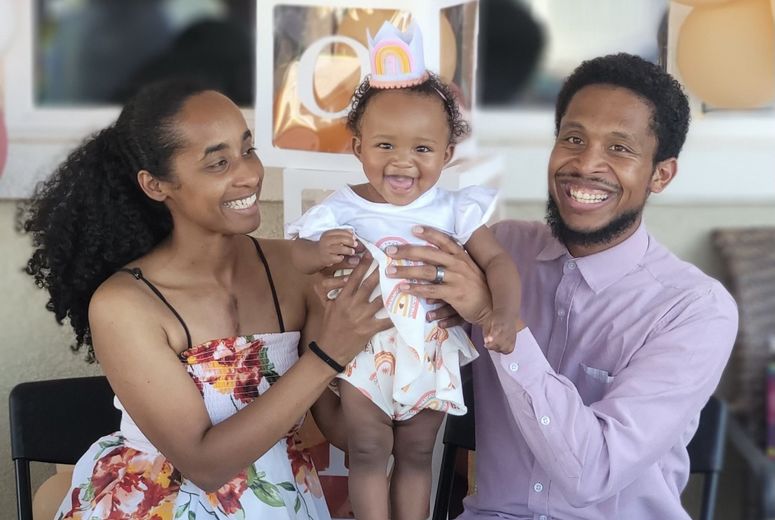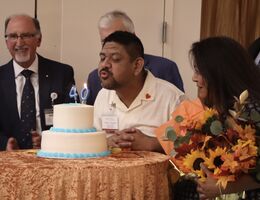

Dominique Labian had a successful pregnancy after removing her LVAD that was used to treat her congestive heart failure.
When Dominique Labian gave birth to her daughter, Faith, at 37 weeks, it marked a triumphant milestone in her extraordinary medical journey — one not yet documented in medical history. After about a decade of battling severe heart failure that required a left ventricular assist device (LVAD), followed by a successful heart recovery without the need for a transplant, Labian's resilience and faith culminated in the birth of a healthy baby girl. Her recovery and successful pregnancy after LVAD removal, considered a rare and unprecedented case, is a testament to the specialized care and support she received at Loma Linda University Health.
"To our knowledge, this case represents the first documented successful pregnancy after LVAD explantation," stated Labian's care team including Dmitry Abramov, MD, advanced heart failure, and transplant cardiologist. Her medical course from LVAD, to LVAD removal, and to a successful pregnancy was novel enough also be published in a scientific medical journal.
Read more about this case from Labian's care team here.
Road to recovery
Years before Faith's birth, Labian faced severe health challenges. She was diagnosed with congestive heart failure, a condition rendering her heart unable to pump enough blood to meet her body's needs, and it quickly worsened. To save her life, doctors implanted an LVAD, a mechanical device that helps the heart pump blood. It's often seen as a bridge to a heart transplant, as most patients with LVAD don't regain enough heart function to live without it.
Although this device helped saved her life, Labian's long-term outlook seemed insurmountable. She fought her way through the initial challenges and insisted on beating the odds. Suddenly, her heart showed signs of recovery, a rare occurrence for patients in her condition. After years of weaning off the LVAD, her heart had improved enough that the LVAD could be safely removed.
"I think even my doctors were surprised," Labian said. "The LVAD gave my heart the rest and time I needed to believe and fight for my healing."
Still, the question of pregnancy remained a daunting one. Would her heart be able to handle the stress of carrying a child? Pregnancy after heart failure, particularly for someone who had required an LVAD, was uncharted territory. Her doctors monitored her heart function closely, balancing the excitement of her potential motherhood with the risks that could accompany it.
"It didn't take long for my husband and I to get pregnant," Labian said laughing.
A healthy birth
Throughout her smoothly progressing pregnancy, Labian's medical team closely monitored her heart function, which remarkably stayed stable during her pregnancy.
"To this day, my heart is functioning well… better than expected, really," Labian said.
At 37 weeks pregnant, Labian went into labor. Despite the whirlwind of emotions surrounding the impending birth, the delivery was smooth, with the brief use of forceps to assist in the final stages. She gave birth to her daughter, Faith, who weighed 4 pounds, 15 ounces. Although small, baby Faith didn't need time in the neonatal intensive care unit (NICU) — a remarkable outcome, considering her mother's complex health history.
"She was tiny," Labian said, reflecting on those first moments. "But she was perfect. She didn't need any NICU time and hit all her developmental milestones early. She started walking at 11 months and talking soon after. She's small but mighty and so full of life."
Throughout her journey, Labian leaned on her faith, a guiding force during her recovery. Her daughter's name, Faith, symbolizes the spiritual resilience that helped her through some of the darkest times of her life.
"My faith really carried me through. I had to keep believing that everything would work out. I had so much support from my doctors, family, and church but my faith kept me hopeful even when things were difficult," Labian said. "When I felt weak and things were difficult, I was surrounded by those who believed with me."
Continued health journey
Though Labian's health challenges aren't entirely behind her, she's living a full and active life with her husband and daughter. She continues to visit her medical team for routine checkups, particularly to monitor her heart. While she takes medication to manage her heart function and prevent seizures caused by scar tissue from her previous surgeries, her overall health has remained stable.
"I feel strong," Labian said. "I'm able to do everything I did before. I feel good, and I'm thankful I can run and play with my daughter. It could be a different day for me."
Labian's case is rare and has become a source of inspiration for the medical team and other patients facing severe health challenges. Her recovery after LVAD removal and her successful pregnancy without complications highlight the strength of specialized care offered at Loma Linda University Health, particularly in managing high-risk pregnancies and complex cardiac cases.
"We don't see many cases like Dominique's," Abramov said. "Her heart recovery and pregnancy were exceptional, and her resilience was remarkable. It was a team effort to ensure her and her baby's health."
As Labian watches Faith grow into a lively, curious toddler, she is grateful for the medical advances that helped save her life and the faith that kept her going.
"I can't take credit for a miracle," Dominique said. "But I can go on living a life full of joy and gratitude. And I'm reminded to be thankful every day for the journey I've been given."
Loma Linda University International Heart Institute's unique approach to multidisciplinary care brings together doctors across multiple medical specialties to develop comprehensive, personalized treatment plans tailored to each patient's needs, requirements, and overall well-being. Learn more about the services offered.



